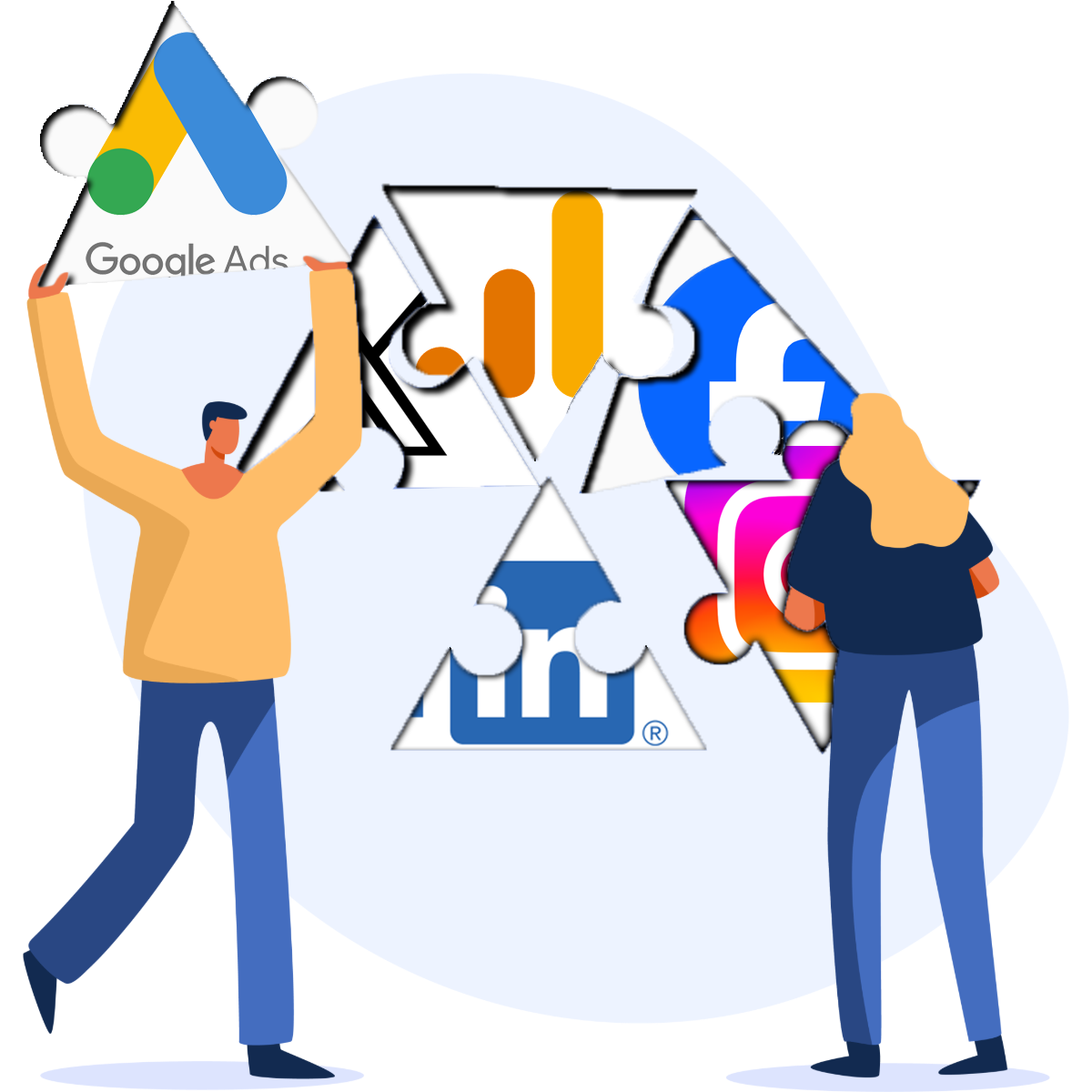
We’ve recently had a small wave of business owners and leaders asking where to start, or how to reboot their digital advertising after many years. No surprises, things have changed! Perhaps a good time to review the basics.

Embarking on digital advertising in B2B can be overwhelming – there are countless platforms, formats, metrics, and recently the influence of AI in the digital ecosystem to consider. And while asking an AI model to help can be useful, without the right foundational mindset and strategy, B2B advertising can be a deflating experience and fall flat by not showing results, attracting the low-value leads, or being very costly. Unlike B2C, you’re not chasing transactional results; you’re building trust with decision-makers who take time to commit.
Here are five practical steps to start advertising online in B2B with focus and confidence.
- Define Who You’re Talking To, A Step Further
- Have a Funnel Strategy
- Craft An Authentic Message
- Understand Your Competitors’ Ads
- Measure Past The Web, Past the Pipeline, To Conversion
- Get Help
1. Define Who You’re Talking To, A Step Further
Most business have a good sense of who their users are, no surprise there! But a successful digital marketing strategy requires a deeper level of understanding. B2B, in particular, has sales cycles that are often long, involving different people influencing the sale with different profiles. Choosing who to target within this group of people or buying committee is often a challenge.

So, before you spend a single yen or dollar, get clear about who you want to reach. Should you focus on the pain points for the business’s end-user? Surely communicating a value proposition for an end-user can get everyone on board, right? But how about the technical leads involved in decision-making? They often have the power to derail the most enthusiastic coworkers that have bought into a value proposition. How about the financial teams? If pricing, ROI, and finance related messaging does not resonate, CTOs are going to block negotiations before they start.
Trying to present a value proposition for all decision makers may not be the most effective strategy. But also, B2B transactions tend to be decided by a group of people, so hyper-focusing the message may also have some backlash.
When you know what they care about (efficiency, innovation, cost savings, or growth) your message will help writes itself.
To illustrate, let’s create a theoretical SaaS company that provides enterprise eSignature’s SaaS services. Consider the different messaging, can you tell the audience is targeting?
- “Send, sign, and close from anywhere — no more chasing paperwork.”: Focus on users.
- “Keep your documents secure and compliant — with single sign-on and full audit trails.”: Focus on tech teams.
- Cut document handling costs by 60% and free your team from admin overhead.”: Focus on finance teams.
These messages are intended for end users, tech leads, and finance leads respectively. There is no silver bullet, but knowing your audience is essential.
2. Have a Funnel Strategy
B2B advertising can serve very different purposes depending on where you are in the funnel, and you must be clear on what you’re trying to achieve. Not only at a strategic level, but at a tactical level too!
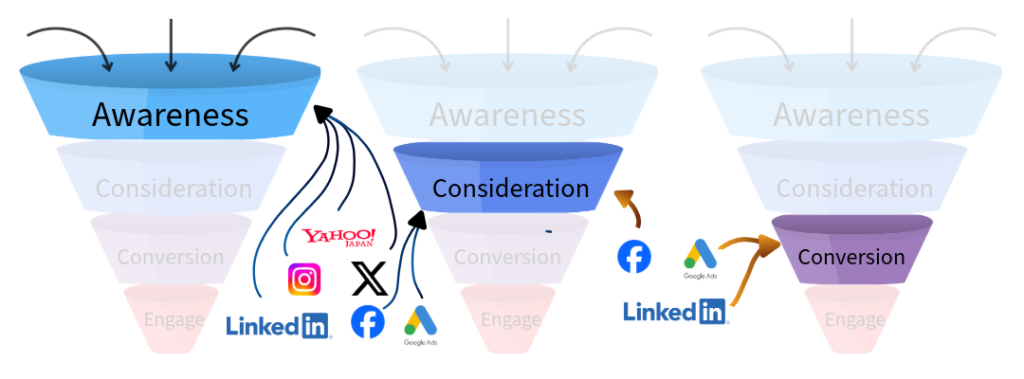
Ask yourself:
- Do people know my brand or product? Do I have enough materials to showcase it? Am I trying to generate top-of-funnel prospects?
- Do you want to generate qualified leads (like demo sign-ups or downloads)? Other actions that would be closer to a mid- or lower-funnel tactics?
- Or are you focused on account-based marketing, reaching a defined set of target companies?
Each goal requires a different message, offer, and measure of success. Knowing your strategy helps you spend smarter and interpret results correctly.
Ad platforms will ask about this when you design your campaigns, and the settings will be different depending on your objective. They need this information to adjust how they target audiences, bids, and optimize for the right thing.
Major Platforms’ Campaign Types
Here are three major advertising platforms, and some of the campaign types you can leverage.

- Performance Max (Full Funnel): Leverages all Google properties to optimize for the set goal.
- Display Campaigns (Upper Funnel): Showing ads in various sites.
- Video Campaigns (Upper Funnel): Shows videos on YouTube and affiliated sites.
- Demand Gen Campaigns (Upper-Middle Funnel): Good to drive interest for your brand or product.
- Search Campaigns (Middle-Lower Funnel): Good for sales and lead generation, tighter controls.
- App Campaigns (Middle-Lower Funnel): Targeting ad space in mobile apps.
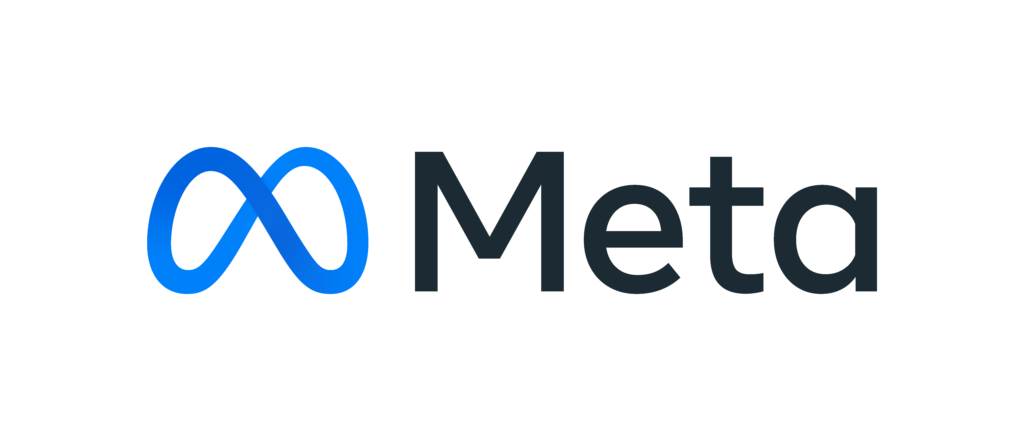
- Awareness Campaigns (Upper Funnel): Focus on reach and impressions.
- Traffic Campaigns (Upper-Middle Funnel): Designed to drive clicks to websites or landing pages.
- Engagement Campaigns (Upper-Middle Funnel): Helpful for building community and social proof.
- Lead Campaigns (Middle-Lower Funnel): Effective for lead generation.
- Sales / Conversion Campaigns (Lower Funnel): Use Meta Pixel or Conversions API to track actions on your website — best for lower-funnel strategies like purchases or sign-ups.
- App Promotion Campaigns (Middle-Lower Funnel).: Drive installs or engagement for mobile apps.

- Brand Awareness (Upper Funnel): Increase visibility and familiarity.
- Website Visits (Middle Funnel): Drive traffic to your site.
- Engagement (Middle Funnel): Encourage community interaction.
- Video Views (Middle Funnel): Showcase stories or customer success through video.
- Lead Generation (Lower Funnel): Collect leads directly in LinkedIn using pre-filled Lead Gen Forms.
- Website Conversions (Lower Funnel): Encourage conversions on your site.
Don’t feel you need to use all at the same time either, but start with more than one.
3. Craft An Authentic Message

Once you know who you’re talking to and what your strategy is, take the time to craft a purposeful message.
Writing effectively is hard – it takes time, empathy, and clarity. It is tempting to just leave this to your favourite AI, but as automated writing becomes common, authenticity becomes the real differentiator.
There are plenty of messaging frameworks to help teams stay consistent, but nothing replaces talking directly to the people you’re trying to reach. Listening to how they describe their challenges often reveals the words and tone that will make your message resonate.
💡 Tip: Talk About Solutions, Not Features
It’s easy to fall in love with our product, its features, the technology it has – faster processing, smarter AI, new integrations – basically, what it does. But audiences do not buy features or products; they buy solutions to their problems.
We may love the specs of futuristic concept cars, but most people care more about whether it fits our kids and luggage than about engine torque.
Let’s take a pretend cyber-security company, for example.
⚠️ Feature-focused: “AI-driven malware detection and advanced endpoint protection.”
✅ Solution-focused: “Stop cyberattacks before they disrupt your business.”
⚠️ Feature-focused: “Real-time monitoring with automated alerts.”
✅ Solution-focused: “Sleep better knowing threats are handled the moment they appear.”
Or a pretend SaaS call center
⚠️ Feature-focused: “Our platform offers omnichannel routing and real-time analytics.”
✅ Solution-focused: “Connect with customers on any channel, and resolve issues faster.”
⚠️ Feature-focused: “Includes AI-powered voice bots and intelligent call distribution.”
✅ Solution-focused: “Reduce wait times and let agents focus on conversations that build loyalty.”
⚠️ Feature-focused: “Advanced reporting dashboards and performance metrics.”
✅ Solution-focused: “Know exactly where your customer experience breaks.”
That subtle shift – from describing features to showing outcomes – makes your message more human, relatable, and memorable.
Keep it simple. Focus on one clear benefit per campaign instead of trying to communicate everything at once.
4. Understand Your Competitors’ Ads
Surprisingly, many business owners don’t realize they can view any advertisers’ ads through “ad libraries.”
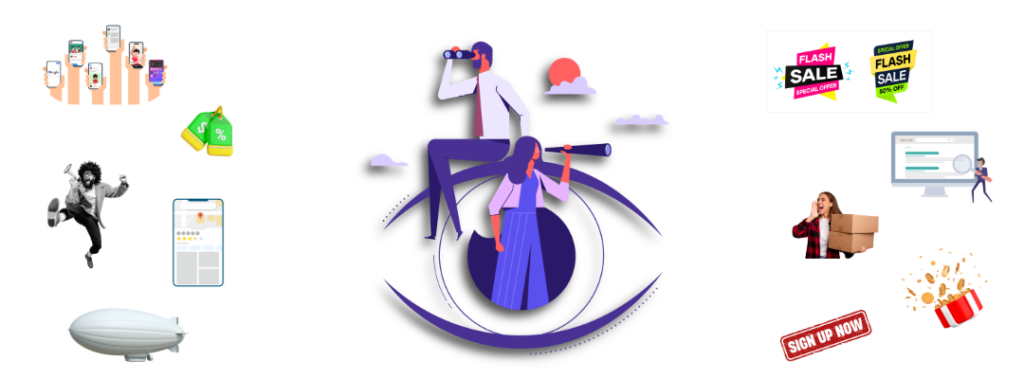
The first ad libraries appeared around 2018 as a response to growing concerns about transparency in political advertising during U.S. elections – credit to Facebook for being the first major platform to take this step. Over time, the idea evolved beyond politics, expanding to promote greater transparency and accountability across all types of advertisers.
Today, ad libraries are valuable tools for understanding your industry’s messaging landscape. By exploring what ads are currently running, you can gain insight into your competitors’ strategies — and find inspiration for how to make your own brand stand out.
Some of the insights new advertisers can extract from looking at competitors include:
- What message are they emphasizing? Features, solutions, any particular angles?
- Message around pricing. Are they showcasing pricing, sales, discounts?
- What formats are they using? Are they using video, downloads, images, people or illustrations, etc.
There are countless of questions your team can validate or get directional feedback when looking at competitors.
Here are three ad libraries worth exploring:
Google Ads Transparency Center
First introduced in 2023, the Google Ads Transparency Center allows users to search and view ads that have run across Google platforms, including YouTube, Search, and Display. It’s designed to promote accountability by showing ad creatives, regions shown, and advertiser information.

Meta Ads Library
Launched in 2019, Facebook’s Ad Library offers public access to all active ads across Meta platforms (including Instagram). It’s part of Meta’s efforts to increase transparency in political, issue-based, and commercial advertising.
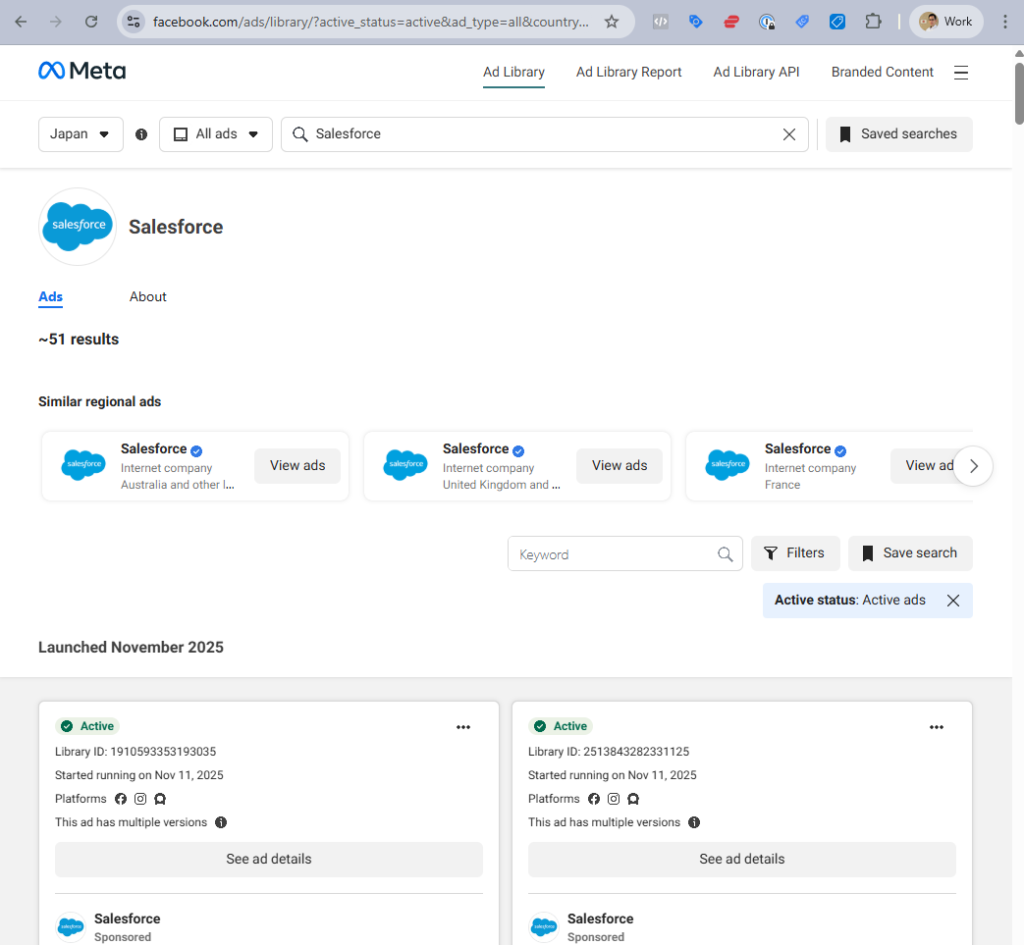
LinkedIn Ads Library
LinkedIn introduced its ad transparency tool in 2023, enabling users to view ads run by specific advertisers. While more limited in scope compared to Google or Meta, it still provides insights into the types of sponsored content companies promote on the platform.
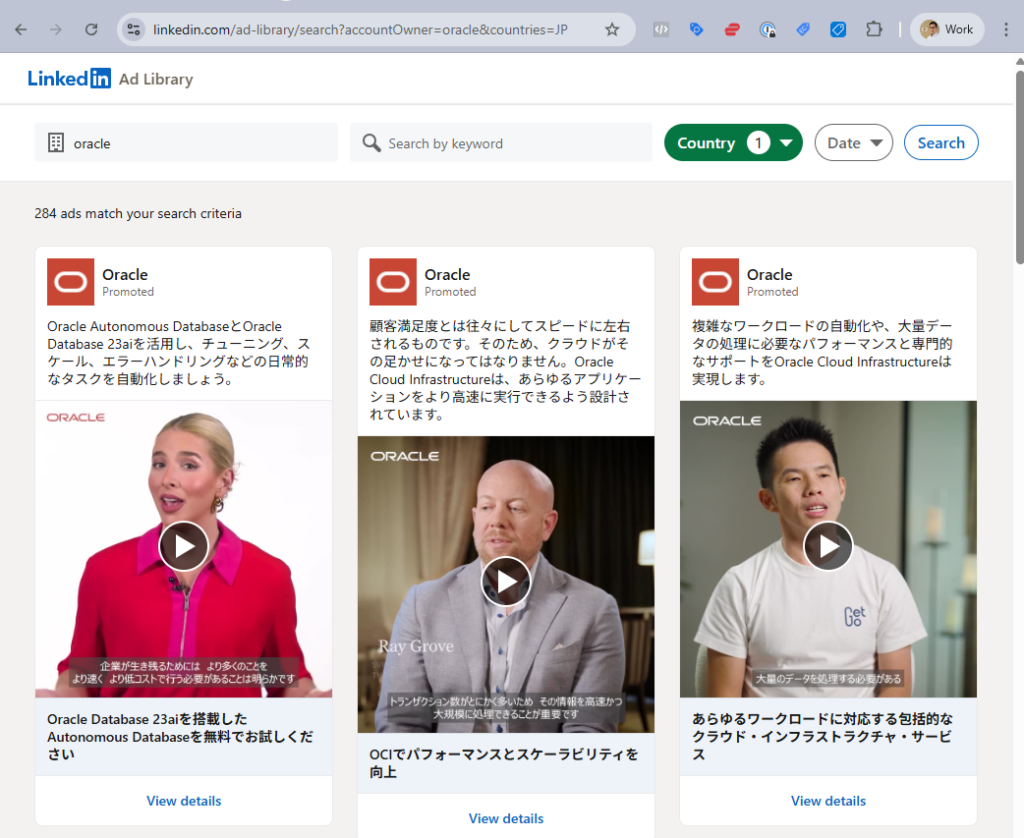
It’s not about copying — it’s about understanding the current conversation and identifying your own voice.
5. Measure Past The Web, Past the Pipeline, To Conversion
Marketers already know data is important, but in B2B, understanding success can be complicated. Digital strategies are often great at capturing and nurturing leads, but when it comes to business-to-business, the actual sale or contract happens much later than the lead capture.

On top of that, the measurement ecosystem is having some growing pains at the moment. New measurement strategies, privacy concerns, government regulation, increasingly sophisticated consumer journeys, and AI are all making it difficult to understand what to do. But we have to start somewhere.
💡Tip: Before jumping into the tools, review your strategy and the questions you want to have answered – more awareness? Downloads? Leads? This is going to make your life much easier.
There is more than one way to measure performance online. Understanding the options will allow you to prioritize. Consider attacking measurement strategies from three key different perspectives: the advertising platform (easy), your website or app (less easy), and your server (hard).
The Advertising Platforms

All advertising platforms allow you to set tags to track conversions. Meta has the meta conversion pixel. Google Ads has its conversion tag. LinkedIn has its Insight Tag 2.0. These are important to set up – particularly for upper funnel tactics.
You might be tempted to rely solely on your web analytics, but platform tags will help feed the platform’s algorithms for better targeting and performance, as well as enable more powerful reporting.
When it comes to upper-funnel tactics, metrics like view-through conversions — when someone views an ad and later completes a conversion -, post-click conversions, cross-device conversions, modeled conversions – there is a long list of reasons why you want to make sure you set up the platform’s conversion tag.
Your Website

Google Analytics (GA4) has become a foundational tool for digital advertisers regardless or company size or strategy. Often used as the main source of truth for web analytics, and sometimes paired with other tools like Adobe Analytics, Piwik, or custom analytics, just to name a few. Regardless of the tool, having a solid web analytics strategy is critical to pull insights and create action plans.
Insights teams will want to keep an eye on are traffic sources (where the users are coming from your site), conversions and micro-conversions (“key events” in Google Analytics terminology), landing page performance, and the rest.
If you are using Google Analytics, make sure you integrate your GA4 property with Google Ads, BigQuery, Google Search Console, Google Merchant Center and whatever else you are using.
Also consider more advanced integrations like cost import from advertising platforms including Meta, Pinterest, Reddits and others.
Your Server
For more advance users, server-side analytics will provide better data and a more flexible environment to augment data with personal identifiable information you can later use internally for further analysis. Most tools have this type of feature. In the case of Google, make sure you review “Server-side Tag Manager”.
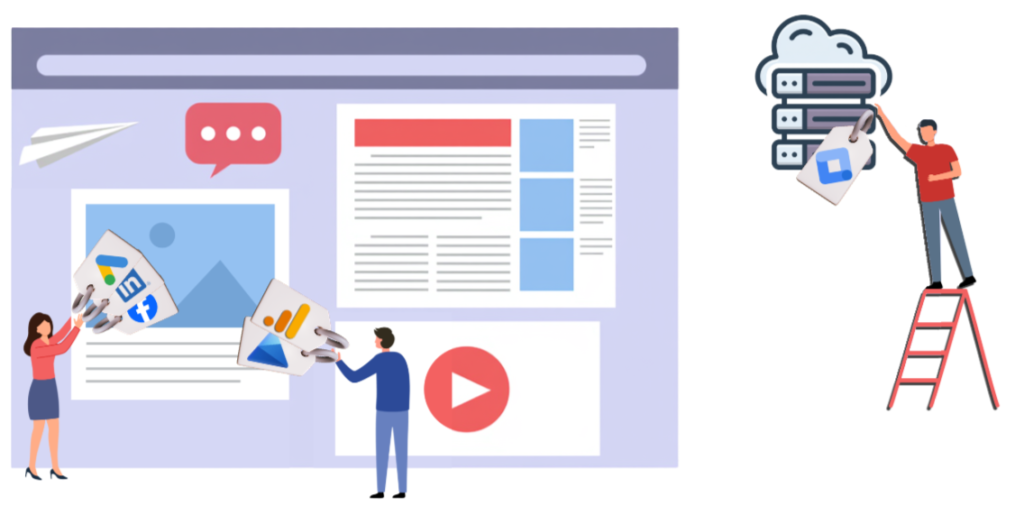
6. Get Help
When you hit the limits of what you can manage alone or internally, bringing in expert help is worth the investment.
Depending on your needs you may want to consider hiring internally, a freelancer or an agency. A brief audit or consultation from an experienced agency can often save you time, budget, and missed opportunities.

It is important to approach this step with a long-term perspective. At Ayudante, for example, even though we have earned partnerships and certifications with most major advertisers (Google, Meta, Yahoo Japan, X, etc.).
Final Thoughts
Getting started with digital advertising in B2B doesn’t require a massive playbook — it requires clarity, consistency, and a willingness to iterate. There is more than one way to measure performance online.
When you know who you’re talking to, understand where they are in the funnel, and communicate solutions rather than features, everything else becomes simpler.
Start with a few channels, stay curious about what the data is telling you, and track more than just clicks — track the moments that genuinely move business conversations forward.
Once these foundations are in place, scaling becomes much less intimidating. You’ll make better decisions, create more resonant campaigns, and ultimately use digital advertising the way it’s meant to be used: to build trust, momentum, and long-term growth.

(グローバル)






